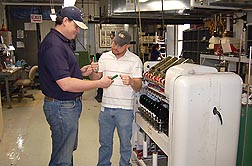Assessing Cotton Fiber Quality From Tiny Sample
At a time when there is an uptick in U.S. cotton exports, it’s not surprising that the Agricultural Research Service’s Southern Regional Research Center (SRRC), located in New Orleans, Louisiana, upgraded its cotton textile pilot plant. There, materials engineer Christopher Delhom has successfully “reimagined” model spinning equipment, outfitting it to be able to spin as little as 30-60 grams (1-2 ounces) of cotton fibers grown from selected experimental seeds. The tiny batch of fibers can be quickly tested to gauge the new varieties’ fiber performance and viability for use on standard equipment and in textiles.
Says James Rodgers, who heads the Cotton Structure and Quality Research Unit at SRRC, “We can use this miniature processing to accomplish in 2 weeks what would take months to test on a full-scale industrial fleet of textile machinery.”
Cotton grows and performs differently based on region and seed genetics. Large-scale processing equipment is customized to accommodate those regional features. But a small change in seed breed can greatly affect the quality of the cotton’s fibers during processing and through to finished fabric. Getting timely information about the processing performance of newly bred cotton varieties is key.
“The machinery is capable of taking a very small fiber sample grown from test seeds and processing those fibers all the way through the milling process into yarn and fabrics,” says Rodgers. In the past, this kind of testing took place at a pace of less than 200 samples per year, using samples weighing from 25 to 150 pounds each.
Delhom knew that cotton breeders from academia, industry, and even governments were waiting up to a year for standard facility equipment to free up before fibers grown from large samples of their experimental seeds could be tested. “New-variety fiber samples need to be spun into yarns and tested for their viability for use in fabrics,” says Delhom. The fast turnaround of the “miniature spinning” approach allows for prescreening of promising varieties to come up with a subset of candidate varieties to test later on full-scale machinery.
The pilot plant’s miniature-spinning equipment is being used to process fiber samples in the National Cotton Variety Trials, which is an ARS-led national trial of varieties involving U.S. breeders. “We are helping producers decide which commercial varieties to plant,” says Delhom.
Rodgers notes that the fiber test results are very important to breeders, because they need to know which varieties to focus their efforts on. They want to know how the fibers will act inside the machinery used to make textiles and clothing.
Delhom’s team is also miniature-spinning a large number of samples for an ARS geneticist and, on the gin side, for an ARS agricultural engineer to evaluate the effect of various gin and harvester settings and gin trials.—By Rosalie Marion Bliss, Agricultural Research Service Information Staff.
This research is part of Quality and Utilization of Agricultural Products, an ARS national program (#306) described at www.nps.ars.usda.gov.
Christopher Delhom and James Rodgers are in the USDA-ARS Cotton Structure and Quality Research Unit, Southern Regional Research Center, 1100 Robert E. Lee Blvd., New Orleans, LA 70124; (504) 286-4228 [Delhom], (504) 286-4407 [Rodgers].
"Assessing Cotton Fiber Quality From Tiny Sample" was published in the October 2014 issue of Agricultural Research magazine.







